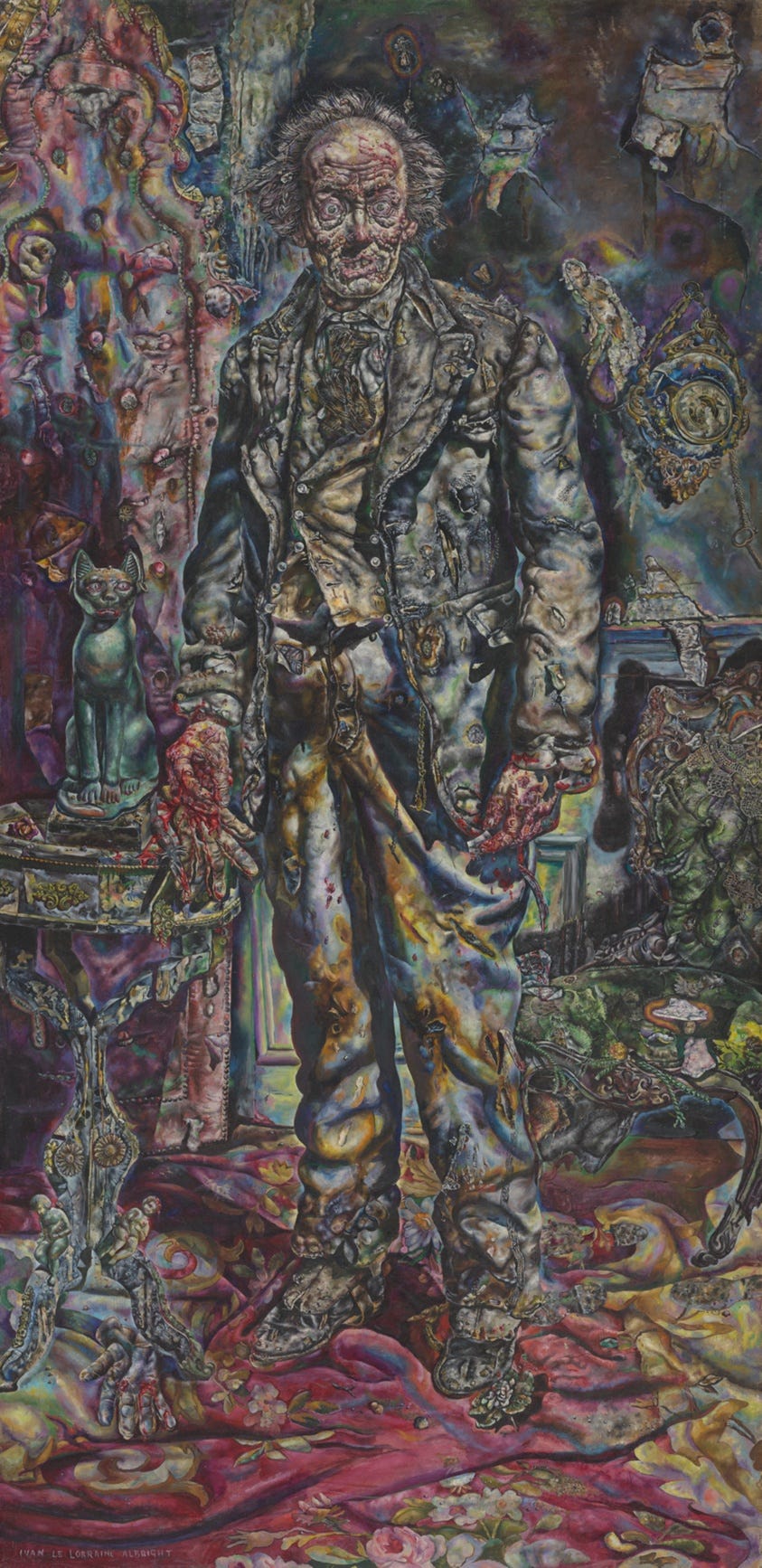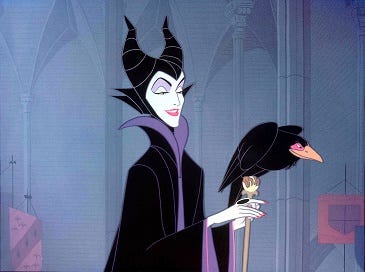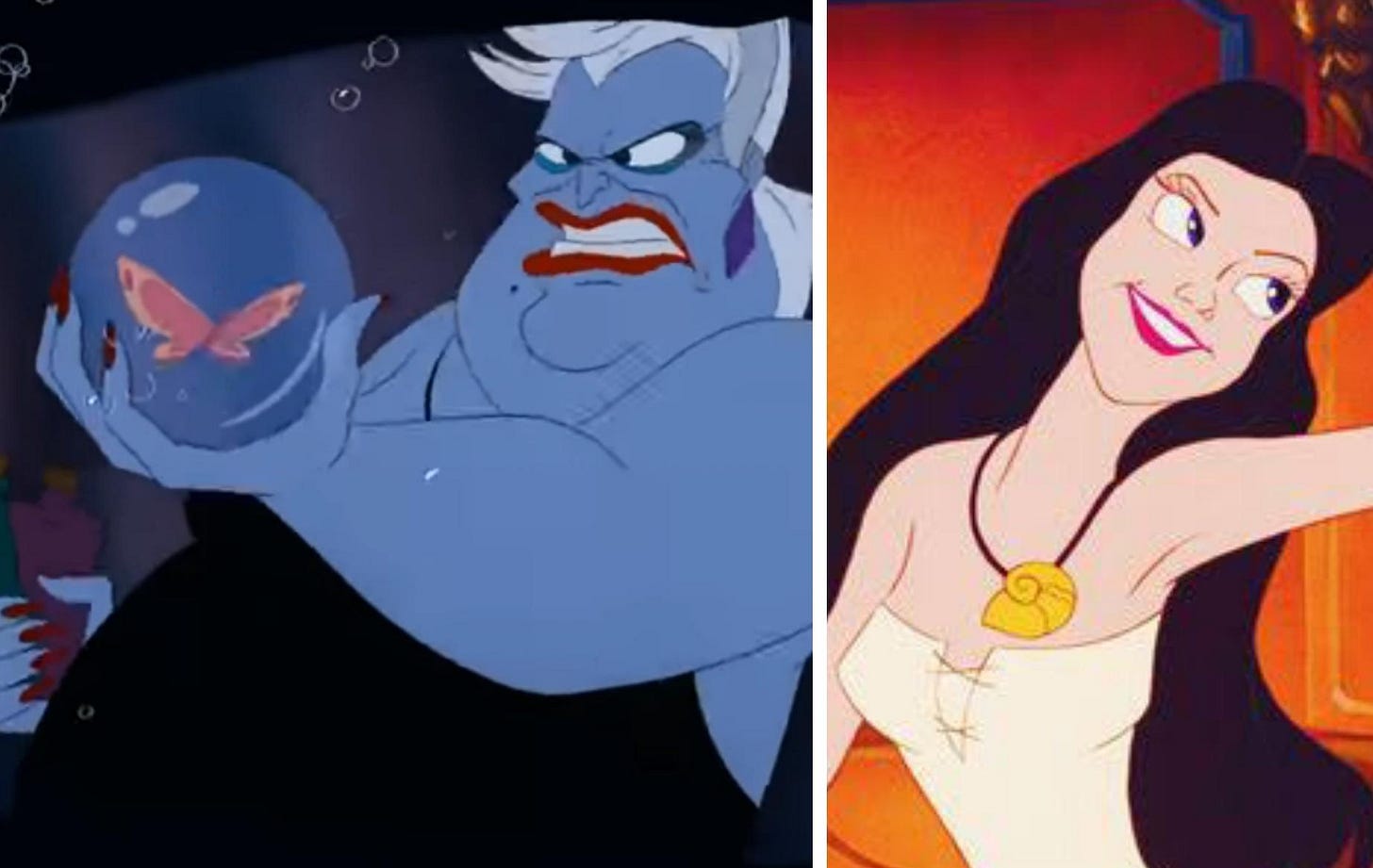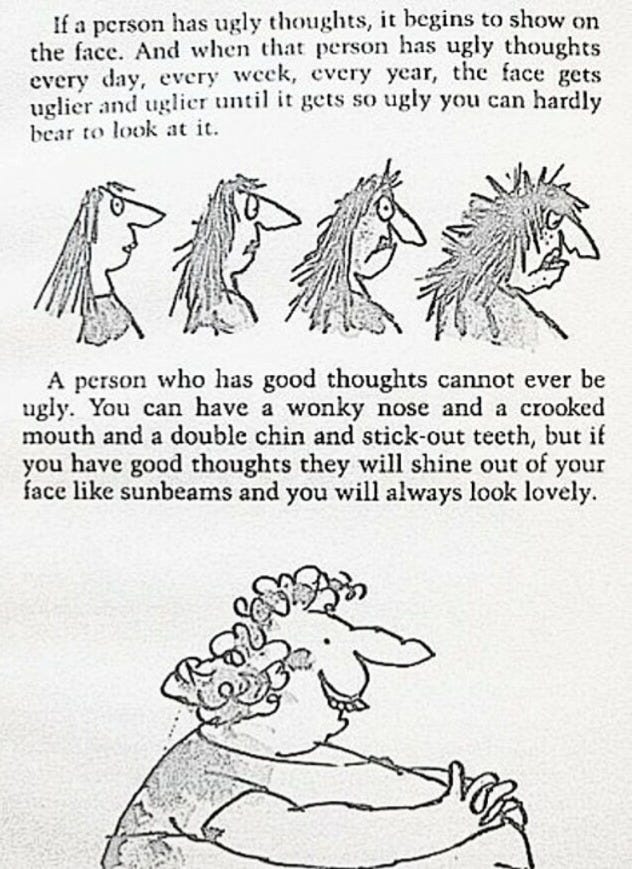
What does evil look like?
I’m not talking about mass starvation or ethnic genocide, incurable diseases or serial killers—those are things that are evil.
Maybe the question should be rephrased: why do some things look evil?
Think the stereotypical mustache-twirling villain, or an evil twin from a parallel universe sporting a goatee. A smirk as opposed to a smile, even though both are just an upturning of the lips and a twitching of the facial muscles. Or even the “aesthetic evil” of the goth subculture which intentionally turns all things dark and morbid into a fashion style.
The question remains, but it’s a bit of a non sequitur, at least from a Thomistic perspective. In that view, evil does not, strictly speaking, exist. It’s not a thing, a substance in and of itself. Rather, evil is the privation of the good. A void that should be filled. A shadow where light should be. A cavity where there should be a tooth.
Nothing where there should be something.
Things are good because God created them. But when those created things are missing something they should have—cruelty where there should be kindness, starvation where there should be satiety, harm where there should be health—that lack is the thing we call evil.
The shadow analogy seems to be the most useful. Just as happy, healthy people are said to have a certain glow about them, a miserable person is said to have a dark cloud hanging over his head (as opposed to a halo).
Darkness, of course, is the absence of light, and light is what allows us to see God’s good creation—so it follows that, metaphorically speaking, darkness=bad, light=good.
This is the message we have heard from him and proclaim to you, that God is light and in him is no darkness at all.
Jesus Himself, famous for speaking in metaphors, used the light/dark dynamic to speak on good/evil, particularly in the Gospel of John:
And this is the judgment, that the light has come into the world, and men loved darkness rather than light, because their deeds were evil. For every one who does evil hates the light, and does not come to the light, lest his deeds should be exposed. But he who does what is true comes to the light, that it may be clearly seen that his deeds have been wrought in God.
We can’t see evil, but we can see the ravaging, devastating effects of it all throughout our sinful, fallen world.
Darkness as a synonym for evil also helps explain why the all-black-everything fashion sense of the aforementioned goth subculture looks evil. No one thinks goths are evil for wearing black lipstick, or that fans of The Cure are secretly torturing puppies or whatever (well, maybe your Grandma does)—just that they look evil, in a purely aesthetic, almost Platonic sense.
I mean sure, the goth girl clad in black, covered in tats and with a face full of piercings might secretly have a heart of gold, but ask yourself, based purely on first appearances, would she look more at home in Bowser’s Castle with its spiked spires and lava dungeons, or the Mushroom Kingdom with its pink princesses and happy-go-lucky Toads?1

(That said, it does go a bit further than that, I’m sorry to say: visit any goth fashion brand’s website and prepare to be bombarded with upside-down crosses, devil horns, witches and vampires, and scantily clad women rocking pentagrams PJs and Baphomet brassieres.2 )
Again, not all goths (for what it’s worth, I like to wear black myself) but it should give Christians pause for concern.
Even more so than the darkness connection, the death connection gives goth its “evil” bona fides. What is death, after all, but the ultimate evil, the terminal consequence of all our sins?
For the wages of sin is death, but the free gift of God is eternal life in Christ Jesus our Lord.
Jesus wept over the death of His friend Lazarus, even though He knew and could and would bring him back to life, emphasizing just how tragic death (and sin) truly is.
Death is evil not just in the metaphysical sense, but the physical as well: rigor mortis, bloated corpses, foul smells, rot and decay, et cetera. In other words, death—and its cause, evil—is ugly. Where the transcendental of beauty is absent, ugliness remains.
In the eschaton, our frail, sickly bodies will be glorified and perfected. But in the meantime, we must contend with the ugliness of sin and its unsightly effects on the flesh.
Theologians are free to speculate on to what degree “natural evils” like poisonous insects and bad weather fit into God’s original Edenic plan for creation, but disease is clearly a side effect of sin—not, it can’t be stressed enough, because the person suffering from disease “deserves” it as punishment for their personal sins,3 but because Original Sin has thrown the order of the Universe out of whack.
Deformities are ugly because they’re unnatural.4 Yet evil can just as easily take on the form of beauty as a means to entice one to sin, like an angler fish trapping its prey with its bioluminescent lure.5
Woe to you, scribes and Pharisees, hypocrites! For you are like whitewashed tombs, which outwardly appear beautiful, but within they are full of dead men’s bones and all uncleanness. So you also outwardly appear righteous to men, but within you are full of hypocrisy and iniquity.
Disease and deformity are side effects of original sin, but on an individual level, acting evil can make you ugly—an otherwise normal-looking person can look like a villain if their body language is bad enough (shifty eyes, sneering countenance, mirthless laughter, poor posture, et cetera).6
The eye is the lamp of the body. So, if your eye is sound, your whole body will be full of light; but if your eye is not sound, your whole body will be full of darkness. If then the light in you is darkness, how great is the darkness!
This is a common visual motif in fiction,7 from the comically hideous Dick Tracy villains to the physical degradations Anakin Skywalker and Chancellor Palpatine undergo the further they move toward the dark side of the Force in Star Wars.

But the same is true in the real world: sloth and gluttony can make you morbidly obese, drug addiction can transform you into a skeevy track-marked junkie, joining extremist political cults can turn you into a mugshot meme, and gazing into the dark abyss of occultism can give you the haunted, thousand-yard stare of a Grigori Rasputin or an Aleister Crowley.
The higher you are the harder you fall. Lucifer was the brightest of the angels, but after rebelling against God he became Satan, a snake slithering on its belly. Angels become demons, elves become orcs, and men become monsters.
This phenomenon is found in art and architecture as well—look no further than the Brutalism of communist countries (only an atheist could conceive of such abominations!) or the nihilistic paintings of the postmodern movement. A rickety house with rotted wood, cracked windows, and an overgrown lawn spells danger. So too with an unkempt human or anything else that isn’t as it should be.
All this should lead us to conclude that books should, in fact, be judged by their proverbial covers. And to that I’d say yes—as Jesus advises His apostles, we must be discerning in our judgements, “wise as serpents and innocent as doves,” using well the rational minds God gifted us with—with the caveat that we must be careful not to take such face value judgements too far.
Because for every Phantom of the Opera who lives up to his villainous visage, there’s a Hunchback of Notre Dame whose hideousness hides the heart of a hero. There’s a world of difference between the kindly old granny baking cookies for her grandkids and the gnarled old hag cooking up a poisonous potion in her cauldron.
Then the righteous will answer him, ‘Lord, when did we see thee hungry and feed thee, or thirsty and give thee drink? And when did we see thee a stranger and welcome thee, or naked and clothe thee? And when did we see thee sick or in prison and visit thee?’ And the King will answer them, ‘Truly, I say to you, as you did it to one of the least of these my brethren, you did it to me.’
Do not neglect to show hospitality to strangers, for thereby some have entertained angels unawares.
We must see Christ in all people, even the weird guy at Mass sitting in the pew across from you wearing the Metallica t-shirt.
You hear a lot about physiognomy and phenotypes these days, especially in rightwing circles. Claims that political ideologies can be ascertained by A.I. craniofacial scans feel like a futuristic version of phrenology, the old “pseudoscientific” theory that claimed a man’s character and personality traits could be judged purely on the basis of his skull shape.
The science may or may not hold up, but one can’t be too careful to avoid devolving (pun intended) into the same eugenicist errors that empowered the likes of Planned Parenthood’s Margaret Sanger and other social Darwinians whose modern day descendants can be found in the abortion and euthanasia movements.
But the Lord said to Samuel, “Do not look on his appearance or on the height of his stature, because I have rejected him; for the Lord sees not as man sees; man looks on the outward appearance, but the Lord looks on the heart.”
Do not judge by appearances, but judge with right judgment.
It’s been said that the greatest trick the devil ever pulled was convincing the world he didn’t exist. But in modern times it can sometimes feel like Satan has abandoned subtle subversion for outrageous audacity.
Evil is everywhere.
Sure, sin has been with us since Adam and Eve first disobeyed God’s commandment and ate the forbidden fruit all those millennia ago, but in a post-Christian world, the effects of that evil are becoming all the more obvious. Yet as disheartening as all the unjust wars, societal collapse, and religious persecutions of modernity are, they also have the benefit of giving us a much-needed wake-up call to the reality of sin and our need for redemption.
So rejoice when evil is foolish enough to let its freak flag fly—because the more acute the sickness’s symptoms, the easier it is to diagnose.
Or Mordor instead of Gondor if you’re more into Middle-earth than Mario
Even the names give the game away: the top three results for “goth fashion brand” on Google are “Disturbia,” “Killstar,” and “VampireFreaks.” Not exactly subtle!
We don’t want to be like Job’s fair-weather friends who blamed him for his misfortunes even though he was blameless
It’s a testament to modernity’s strangeness that the stars of the old circus freak shows are in many ways indistinguishable from “normal” people these days (The Tattooed Man, The Bearded Lady, et cetera)
Evil can hide itself to some degree, but like the sea witch Ursula in The Little Mermaid, even when she transformed, she still exuded wickedness for those paying attention

The good news is the process is reversable!
Additional examples include Théoden and Gollum from The Lord of the Rings




